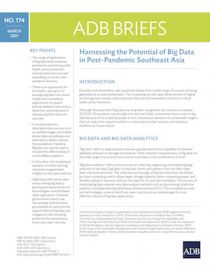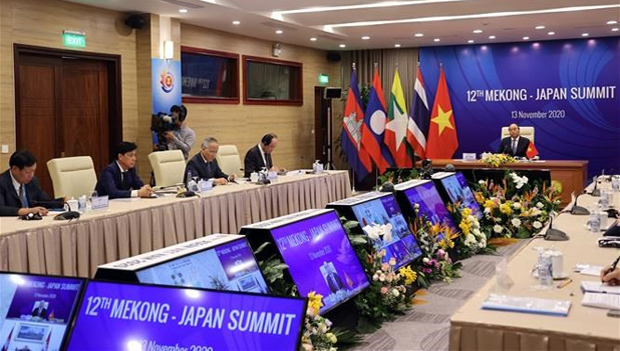
Harnessing the Potential of Big Data in Post-Pandemic Southeast Asia
This brief explains how big data can be utilized in Southeast Asia to boost public service delivery and expedite the coronavirus disease (COVID-19) recovery.
The GMS Regional Health Cooperation Strategy 2024-2030 emphasizes health issues that are regional in nature and require collective action to address. It has two strategic pillars: regional health security and health system strengthening toward universal health coverage.
Scaling Up One Health Approaches in the Greater Mekong Subregion provides an overview of One Health in the GMS and its relationship to addressing climate change. It details One Health activities in the subregion and recommends how they can be scaled up, including specific investment opportunities.
Countries in the Greater Mekong Subregion aim for Sustainable Development Goals for health. Through the Working Group on Health Cooperation, GMS countries are taking comprehensive, coordinated and proactive approaches to address regional health issues.
The Greater Mekong Subregion still experiences high incidence of communicable diseases and drug-resistant microorganisms. GMS countries also suffer from inefficient health systems due to lack of synergies, economies of scale, and scope; and there are few common solutions to common health problems.
The health agenda of the GMS Economic Cooperation Program Strategic Framework 2030 (GMS-2030) will focus on communicable disease control through cross-border surveillance and modeling, information exchange, implementation of international health regulations, and pandemic preparedness. Since universal health coverage is a critical regional public good, GMS-2030 will aim to accelerate its implementation. This will be effected by strengthening the performance of GMS health systems to prevent, detect, and respond to public health threats such as COVID-19 and other emerging diseases; supporting countries to comply with the World Health Organization’s International Health Regulations; applying a unified approach to environmental, animal, and human health (“One Health”); strengthening protection of vulnerable communities and migrants; building capacity and cross-border cooperation to address priority health issues; and advancing gender equality to build subregional health cooperation leadership and decision-making policy. GMS-2030 aims to provide a new setting for the development of this subregion for the next decade.
Regional health cooperation initiatives in the GMS, based on the 5-year strategy that identifies operational priorities for health cooperation for 2019-2023, focus on three strategic pillars:
Strategic Pillar 1: Health security as a regional public good tackles the subregion’s vulnerability to acute public health events. Ensuring robust national health systems with capacity to prevent, detect and respond to transnational health threats is the cornerstone of health security.
Strategic Pillar 2: Health impacts of connectivity and mobility respond to health challenges stemming from an increasingly interconnected GMS. Strengthening health systems in border areas where migrant and mobile populations pass and reside is an entry point for programming. Also includes. integrating health impact assessment during project planning and implementation of GMS urban and transport infrastructure projects.
Strategic Pillar 3: Health workforce development builds on the subregion’s existing human resource capacity to address common health challenges. Strong leadership in turn opens opportunities for intraregional capacity building, utilizing the subregions’ depth of health human resource and health programming experience to tackle shared health issues and enhance country efforts to attain Sustainable Development Goal targets.
The Working Group on Health Cooperation seeks to address collective action problems of regional health investments and limited resources for health that tend to prioritize national investments.
Related
Focal Persons at the Asian Development Bank
Rikard Elfving
Human and Social Development Sector Office
Sectors Group
Najibullah Habib
Human and Social Development Sector Office
Sectors Group
Other Concerned Staff & Consultants
Asadullah Sumbal
Regional Cooperation and Integration Unit
Southeast Asia Department
Mario Randolph Dacanay
Human and Social Development Sector Office
Sectors Group
Rowena Sancio
Regional Cooperation and Integration Unit
Southeast Asia Department/GMS Secretariat
Send inquiries to GMS Secretariat.
Focal Persons at the Asian Development Bank
Rikard Elfving
Human and Social Development Sector Office
Sectors Group
Other Concerned Staff & Consultants
Asadullah Sumbal
Regional Cooperation and Integration Unit
Southeast Asia Department
Rowena Sancio
Regional Cooperation and Integration Unit
Southeast Asia Department/GMS Secretariat
Send inquiries to GMS Secretariat.
After more than 20 years, the Working Group on Human Resource Development was restructured in 2017 to focus on health, given the strategic importance of regional cooperation in this area.
Labor migrants in the Greater Mekong Subregion play a vital role in economic development. The Asian Development Bank (ADB) and the International Organization for Migration (IOM) have organized joint virtual dialogues on labor mobility.
Consequent to the review of the GMS Institutional Framework in 2016 and a separate review of the Strategic Framework and Action Plan for Human Resource Development in the GMS 2013–2017, GMS ministers endorsed the creation of the Working Group on Health Cooperation in 2017.
Human resource development, however, continues to be an important sector in the Greater Mekong Subregion. At an extraordinary meeting of the Working Group on Human Resource Development in Bangkok on 4 July 2017, participants agreed on the following key points:
Related

This brief explains how big data can be utilized in Southeast Asia to boost public service delivery and expedite the coronavirus disease (COVID-19) recovery.

This brief outlines how Southeast Asia can focus on green growth to successfully and sustainably recover from the coronavirus disease (COVID-19) pandemic.
The Asian Development Bank (ADB) and its partners will collectively zero in on strategies and policy responses that countries can adopt to lay the groundwork for post-COVID-19 recovery at the upcoming Southeast Asia Development Symposium (SEADS) Innovation through Collaboration: Planning for Inclusive Post-COVID-19 Recovery.
The region’s success with decades of growth and poverty reduction is due in large part to the international movement of trade, capital, people, knowledge, and resources – not only within the region but with the rest of the world. This type of regional cooperation is also a powerful tool in addressing the pandemic.
Cambodia, Lao PDR, and Viet Nam (CLV) Leaders expressed their firm commitment to strengthen the CLV Development Triangle Area (DTA) in order to accelerate economic growth, alleviate poverty, and promote socio-cultural progress in the subregion. At the 11th CLV Summit held online on 9 December, they adopted a Joint Declaration that provides a foundation for the subregion’s socio-economic development plan until 2030 and the Tourism Development Plan. They also adopted the Development Plan for Sustainable Rubber Industry.
Leaders of Cambodia, Lao PDR, Myanmar, Thailand, and Viet Nam adopted the Phnom Penh declaration at the 9th Ayeyawady-Chao Phraya-Mekong Economic Cooperation Strategy (ACMECS) Summit held on 9 December. The declaration emphasizes post-pandemic socio-economic recovery and preparation for future crises and challenges through public health cooperation and enhanced supply chains. ACMECS leaders stressed the importance of vaccine multilateralism to ensure equitable and safe access to coronavirus disease (COVID-19) vaccines.
The 8th Mekong–Republic of Korea (RoK) Business Forum acknowledged how the RoK and the Mekong countries sustained their trade to 2019 levels amid the pandemic by upholding their trade relations. The Forum was held on 4 December in-person in Hanoi, Viet Nam, and online.
The 24th GMS Ministerial Conference (MC-24) was held on 4 November 2020 with the theme “Pave the way to a more integrated, inclusive, sustainable and prosperous GMS.”
The 11th Economic Corridors Forum (ECF-11) was held on 28 October 2020 with the theme “Boosting Competitiveness, Connectivity, and Community in the Greater Mekong Subregion (GMS) Economic Corridors through Focused and Integrated Spatial Development.”

The 12th Mekong-Japan Summit took place virtually on 13 November as part of the 37th ASEAN Summit and Related Summits. Photo by VNA via VNExplorer.
Japan and Mekong countries convened the 12th Mekong-Japan Summit on 13 November, cochaired by Japan Prime Minister Suga Yoshihide and Viet Nam Prime Minister Nguyen Xuan Phuc. The meeting underscored Japan’s strong commitment to the Mekong subregion and reviewed progress of cooperation between Japan and Mekong countries (Cambodia, Lao People’s Democratic Republic [PDR], Thailand, Myanmar, and Viet Nam) as guided by the "Tokyo Strategy 2018." The Strategy seeks to strengthen connectivity, improve human resource development, and enhance environmental protection.